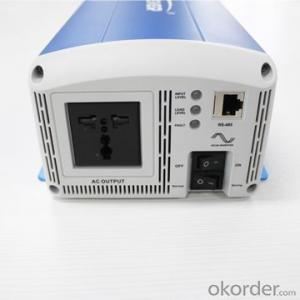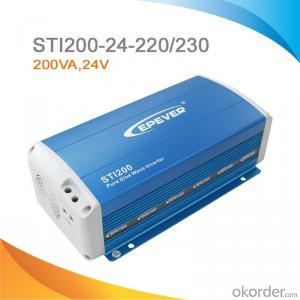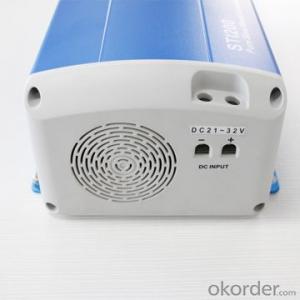Off-Grid Pure Sine Wave Solar Inverter 200W, DC 24V to AC 220/230V,STI200
- Loading Port:
- China Main Port
- Payment Terms:
- TT or LC
- Min Order Qty:
- -
- Supply Capability:
- -
OKorder Service Pledge
OKorder Financial Service
You Might Also Like
Description
STI series is a sine wave power frequency inverter which can convert 12V or 24V DC to 220VAC or 230VAC 50Hz based on full digital and intelligent design. The inverter can be applied in many fields especially for solar photovoltaic power system.
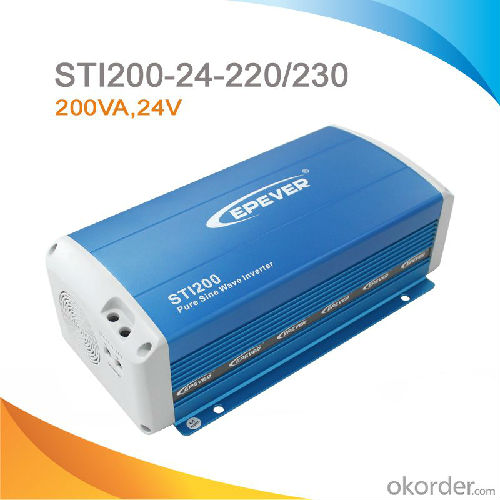
Features:
·Complete isolation-type inverter technology, noiseless output
·Adoption of advanced SPWM technology, pure sine wave output
·Dynamic current loop control technology to ensure inverter reliable operation.
·Wide DC input voltage range
·Excellent EMC design
·Low output harmonic distortion(THD≤3%)
·LED indicators display input voltage range, load power range, normal output & failure state
·Optional energy saving mode
·Wide working temperature range (industrial level)
·Continuous operation at full power
Protections:
·Output Short Circuit protection
·Overload protection
·Input reverse polarity protection
·Input low voltage protection
·Input over voltage protection
·Inverter abnormal protection
·Overheating protection
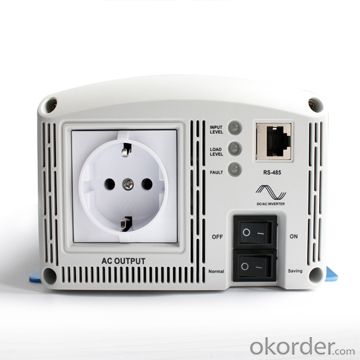
Specification:
Model | STI200-12-220 | STI200-24-220 | |
STI200-12-230 | STI200-24-230 | ||
Nominal battery voltage | 12V | 24V | |
Input voltage range | 10.5~16V | 21~32V | |
Consumption no load(ON) | ≤4W | ≤5W | |
Consumption no load (Saving) | ≤2W | ≤2W | |
Output voltage | AC220/230V±3% | ||
Continuous power | 200VA | ||
Power 10sec | 300VA | ||
Power 1.5sec | 400VA | ||
Surge power | 640VA | ||
Output mode | Single Phase | ||
Wave form | Pure Sine Wave | ||
Frequency | 50Hz±0.2% | ||
Distortion THD ( resistive load) | ≤ 3% | ≤ 2% | |
Efficiency at rated power | ≥81% | ≥85% | |
Max. efficiency | ≥88% | ≥89% | |
Dimension | 315*166*101mm | ||
Net weight | 4.5kg | ||
Working temperature | -20℃~ +50℃ | ||
Humidity | < 95%(non-condensation) | ||
Altitude | < 5000m(Derating to operate according to IEC62040 at a height exceeding 1000 m) | ||
FAQ
Can a solar powered LED lighting without inverter?
Of course you can run lights without inverters. Both LEDs and incandescent lamps are quite happy on DC. And there are fluorescent ballasts that take a DC input (although they do have a sort of inverter inside). I have one in my shed and it has been working just fine for at least 15 years. It is very simple, easy and efficient. You can do away with the electrical code for wiring, lower you cost. Use less energy and lower the cost to install. In fact is we did this to power may of our day to day items we would also lower the demand for power.
Keep in mind this goes against every manufacturer and government policy and you will be shut down, squashed and run out of town for even talking about this, or at least you used to. I am working on a way to use the current wiring in a home to have direct solar, batter bank lighting. By coming off the grid for your lighting and many other functions, a power outage would hardly make a difference to your home.
Does inverter long warranty mean high quality?
SMA did bump up the warranty to 10 years when CSI demanded all inverter manufacturers to do so. The European Sunny Boys are only warrantied for 5 years.
iPhones only have a one year warranty. Does that mean Apple products aren't reliable? Enphase offers a 25 year warranty on their inverters but only one year on their monitoring. Does this mean their monitoring is not as reliable as their inverter? Of course not.
Offering long warranties have very real costs, especially for publicly traded companies like SMA. If we were to offer a 25 year warranty, we would have to hold a higher reserve on our balance sheet, making our products more expensive. We think that our customers would rather have our high quality products at a lower cost.
Start-ups invariably offer long warranties to make up for lack of track record or the perception of quality problems. As the unfortunate recent events at Solyndra have shown, long warranties offered by start-ups can have limited practical value.
Analogies can be drawn to the wind industry: in the early days, customers requested very long warranties (20 years or so), since it was the wild west and no one had a clue about long term O&M requirements for these big new turbines. Now that the wind industry has matured, turbine warranties are again very short (2 years is typical) since the large suppliers have a track record of shipping quality product that does not fail when properly maintained. You could say that PV today is like the wild west environment in wind 10 years ago.
- Q:Can a solar inverter be used with a solar-powered desalination system?
- Yes, a solar inverter can be used with a solar-powered desalination system. A solar inverter is needed to convert the direct current (DC) produced by solar panels into alternating current (AC) that can be used to power the desalination system. This allows for the efficient utilization of solar energy in powering the desalination process.
- Q:How do you connect solar panels to a solar inverter?
- To connect solar panels to a solar inverter, you need to follow a few steps. First, ensure that the solar panels are properly installed and positioned to receive maximum sunlight. Then, connect the positive and negative terminals of each solar panel in series or parallel, depending on the system design. Next, connect the positive and negative terminals of the solar panel array to the input terminals of the solar inverter. Finally, double-check all connections and wiring to ensure they are secure and tight.
- Q:Can a solar inverter be used with a backup power supply (UPS)?
- Yes, a solar inverter can be used with a backup power supply (UPS). The solar inverter can convert the direct current (DC) power generated by the solar panels into alternating current (AC) power, which can then be used to charge the backup power supply. This allows for a continuous power supply even when the solar panels are not generating electricity, ensuring uninterrupted power during power outages or when solar energy is insufficient.
- Q:How does a solar inverter interact with a battery storage system?
- A solar inverter interacts with a battery storage system by converting the direct current (DC) electricity produced by solar panels into alternating current (AC) electricity, which is then used to charge the batteries. The inverter also ensures that the power from the batteries can be used to supply electricity to the loads when there is no sunlight or during a power outage. Additionally, the inverter manages the flow of electricity between the solar panels, battery, and the electrical grid, optimizing the system's overall efficiency.
- Q:Can a solar inverter be used in a hybrid solar system?
- Yes, a solar inverter can be used in a hybrid solar system. A hybrid solar system combines both solar power and another source of energy, such as a battery or grid power. The solar inverter is responsible for converting the DC power generated by the solar panels into AC power that can be used in the home or fed back to the grid. In a hybrid solar system, the solar inverter would still perform this function, allowing the system to utilize both solar and other energy sources efficiently.
- Q:What are the different power output modes of a solar inverter?
- The different power output modes of a solar inverter include grid-tied mode, off-grid mode, and hybrid mode. In grid-tied mode, the solar inverter synchronizes with the utility grid, allowing excess solar energy to be fed back into the grid. In off-grid mode, the inverter operates independently, powering electrical loads directly from solar energy and often utilizing batteries for energy storage. Hybrid mode combines both grid-tied and off-grid functionality, allowing the inverter to switch between grid-connected and standalone operation as needed.
- Q:How does a solar inverter handle voltage and frequency variations caused by voltage sags and swells?
- A solar inverter is equipped with various mechanisms to handle voltage and frequency variations caused by voltage sags and swells. When there is a voltage sag or swell in the electrical grid, the solar inverter employs a technique called Maximum Power Point Tracking (MPPT) to regulate the power output from the solar panels. During a voltage sag, when the grid voltage drops below the normal level, the solar inverter adjusts its MPPT algorithms to ensure that the solar panels continue to operate at their maximum power point. This enables the inverter to extract the maximum available power from the panels and compensate for the reduced grid voltage. By dynamically adjusting the operating point of the panels, the inverter mitigates the effects of the voltage sag and maintains optimal power output. Similarly, in the case of a voltage swell, when the grid voltage increases above the normal level, the solar inverter again utilizes its MPPT capabilities to regulate the power output. It adjusts the operating point of the panels to ensure that they do not exceed their rated voltage, thereby protecting them from potential damage. This allows the inverter to effectively handle the increased grid voltage and prevent any adverse effects on the solar panels. In addition to voltage regulation, a solar inverter also addresses frequency variations caused by voltage sags and swells. It is designed to synchronize with the grid frequency and maintain a stable output frequency. When the grid frequency deviates from the normal range, the inverter adjusts its internal control systems to match the grid frequency. This synchronization ensures that the power output from the inverter aligns with the grid requirements, allowing for seamless integration of solar energy into the electrical system. Overall, a solar inverter utilizes MPPT algorithms, voltage regulation mechanisms, and frequency synchronization capabilities to handle voltage and frequency variations caused by voltage sags and swells. These features enable the inverter to adapt to changing grid conditions, maximize power extraction from the solar panels, and maintain a stable and reliable power output.
- Q:Can a solar inverter be used for three-phase power systems?
- Yes, a solar inverter can be used for three-phase power systems. There are specific three-phase solar inverters available in the market that are designed to convert DC power from solar panels into AC power for three-phase electrical grids. These inverters are capable of synchronizing with the grid and distributing power across all three phases efficiently.
- Q:What is the role of a solar inverter in a grid-tied system?
- The role of a solar inverter in a grid-tied system is to convert the direct current (DC) electricity produced by the solar panels into alternating current (AC) electricity that can be used by the electrical grid or consumed by the appliances and devices in a home or business. It also ensures that the solar energy generated is synchronized with the grid's voltage and frequency to enable efficient and safe transfer of power. Additionally, the solar inverter monitors and controls the flow of electricity between the solar panels, the grid, and any energy storage systems that may be connected to the system.
- Q:Are there any government incentives for installing a solar inverter?
- Yes, there are government incentives available for installing a solar inverter. Many countries offer tax credits, grants, or subsidies to promote the use of renewable energy sources like solar power. These incentives aim to encourage homeowners and businesses to adopt solar energy systems, including solar inverters, by offsetting the initial installation costs and promoting sustainability. It is advisable to check with local authorities or consult renewable energy organizations to understand the specific incentives available in your region.
1. Manufacturer Overview |
|
|---|---|
| Location | |
| Year Established | |
| Annual Output Value | |
| Main Markets | |
| Company Certifications | |
2. Manufacturer Certificates |
|
|---|---|
| a) Certification Name | |
| Range | |
| Reference | |
| Validity Period | |
3. Manufacturer Capability |
|
|---|---|
| a)Trade Capacity | |
| Nearest Port | |
| Export Percentage | |
| No.of Employees in Trade Department | |
| Language Spoken: | |
| b)Factory Information | |
| Factory Size: | |
| No. of Production Lines | |
| Contract Manufacturing | |
| Product Price Range | |
Send your message to us
Off-Grid Pure Sine Wave Solar Inverter 200W, DC 24V to AC 220/230V,STI200
- Loading Port:
- China Main Port
- Payment Terms:
- TT or LC
- Min Order Qty:
- -
- Supply Capability:
- -
OKorder Service Pledge
OKorder Financial Service
Similar products
New products
Hot products
Hot Searches
Related keywords
